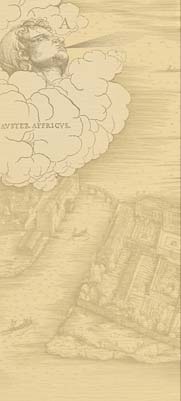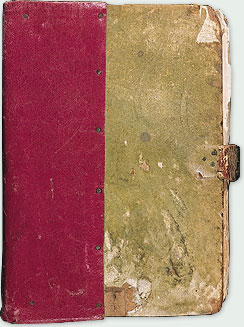Michael's Life: The Manuscript
In 1434, Michael sat down to write out the manuscript for which he is remembered. He recorded his full name of Michalli da Ruodo twice in the 440-page text. Almost all of the manuscript is written in the Venetian dialect, a language that Michael probably learned when he began sailing on Venice's ships at the age of around 16. A memory of his Greek origin survives in the inclusion of two Greek prayers (one of which begs for fever to depart from 'the burning head of Michael')—but these prayers in the Greek language are written phonetically with Latin letters! The effort Michael put into the work was unusual for a man of his status in society. Why did he undertake the project?
Whatever his reasons for preparing the text in life, Michael's manuscript has had a long history after his death.
Birth of the manuscript
Michael's manuscript is a book, with individual pages bound between two covers. The texts Michael copied into it are not random thoughts or daily entries. Instead, they are carefully chosen, carefully organized subjects.
In the days before the printing press, books like these were written by hand. This alone made Michael's effort unusual, since in the Middle Ages many ordinary people could neither read nor write. Moreover, producing a book was expensive. Paper itself was costly, as were pigments for pictures, to say nothing of the labor involved.
Why did Michael go to all this trouble and expense? He never says, but there are three plausible reasons.
A driving factor behind Michael's undertaking was undoubtedly his personal interest in the subject matter. He demonstrated this interest throughout the manuscript, even though it consists largely of texts originally written by others. Even the size of the book—small enough to easily be held in the hands—signifies his interest. Michael made sure his book was portable so he could take it with him to sea.
A second reason is more complicated, having to do with Michael's ambition. At the time Michael wrote his manuscript, he had enough experience to apply for the highest shipboard positions available to a non-noble like himself, particularly armiraio and homo de conseio. These posts were awarded on the basis of annual elections in which Michael competed with a large number of senior mariners of roughly the same level of skill and experience, most of whom were native-born Venetians. The electors all belonged to the noble merchant class. Michael may have been trying to influence their vote directly by demonstrating the breadth of his knowledge.
It's more likely, however, that Michael intended to influence the voters indirectly, by demonstrating how much of their culture he shared. His competitors had the same knowledge he did. But they didn't record theirs in a written format deriving from the abacus schools that provided merchants and nobles with their educational foundation. By showing the electors that he shared their cultural values, Michael would have made it easier for them to appoint him to high position on long voyages, when he would dine with merchants and nobles every night.
If so, writing a book may be seen as a continuation of a project that Michael began when he first went to school to learn to read and write. From his level of understanding, it seems reasonable to speculate that Michael went to abacus school in Venice in the winters during breaks between his voyages as a homo da remo or nochiero. These were the years of Michael's most grueling labor, and the fact that he chose to learn his letters then is a testament to his determination. He needed to be able to read and write and use numbers to do his job. But as Michael's manuscript makes clear, he went far beyond learning the minimum necessary for work, absorbing the cultural interests in mathematics, time reckoning, and astrology of those above him in society.
A third possible reason for writing the manuscript also relates to shipboard life. It has to do with the heavily didactic voice of Michael's text. Whether the subject was math, shipbuilding, or time reckoning, Michael always says he will "teach" the reader how to do it. If we take Michael at his word, the manuscript was at least partially intended for teaching. But who were the students?
Mariners had their own long-standing tradition of imparting practical knowledge to younger sailors. As a junior officer, Michael benefited from this teaching; as a senior officer, he played an important role in training the men beneath him. He may have used the manuscript for this purpose. It should be noted, however, that the instructions contained in the manuscript are not for the kinds of activities that sailors did in the regular course of their duties; these were taught by example and verbal instructions.
Midlife of the manuscript
Whatever the reason that Michael wrote his manuscript in the first place, it continued to be of interest.
Between 1443 and 1445, Michael himself copied part of the text into a second manuscript known as the Raxion de' Marineri (Method for Mariners), apparently believing this text would be interesting enough to sell. This manuscript is in the Biblioteca Nazionale Marciana in Venice with the call number Ms. It., cl.IV, 170 (=5379); it has been published in an edition by Annalisa Conterio (Venice, 1991). Michael's younger contemporary Pietro di Versi was impressed enough with its contents to want to own it. Michael's name is scratched out of the manuscript and Pietro di Versi's name is written over it. Until 2004 it was thought that di Versi was the author of this text, but in that year scholars Franco Rossi and Piero Falchetta of the Michael of Rhodes Project looked under di Versi's name with an ultraviolet light and found Michael's name.
Michael's original manuscript was sufficiently interesting to a mariner of the next generation, paron Giovanni da Drivasto, that he took it to sea. We know this because in 1473 Giovanni wrote his will onto several of the blank pages at the end of the manuscript. It also seems to have been owned by a second person who entered the additional unpaginated portolans that appear after Michael's numbered text.
It is believed that the manuscript may have found its way into the collection of Venetian humanist Giovanni Battista Ramusio (1485-1557), a tireless collector and compiler of writings about geography and travel. Possibly while in Ramusio's collection, but in any case sometime shortly after 1500, three copies were made of the shipbuilding portion of Michael's manuscript. Of these, the most historically important was that copied by Ramusio, which found its way to Florence, where it later became known as the Fabrica di galere. (It is in Florence, Biblioteca Nazionale, with the call number Coll. Magliabecchiana, Cl. XIX, cod. 7.) Other parts of Michael’s manuscripts were read from the copy belonging to Pietro di Versi and were in turn recopied into many other manuscripts.
Subsequently, the copies were forgotten, and Michael's original manuscript disappeared from view.
Modern life of the manuscript
In more modern times, Michael's manuscript has led a sort of double life.
Its first life began in the 1830s, when Augustin Jal rediscovered the copy of Michael's shipbuilding treatise in Florence. It was Jal, perhaps the leading historian of medieval shipbuilding of his time, who named the copy the Fabrica di galere. He published the section of the copy relating to galleys in "Memoire no. 5" of his Archaelogie Navale of 1840, together with a French translation.
Over the next 120 years, Jal's publication attracted the attention of a succession of maritime historians, who have gradually expanded our understanding of the design and construction of medieval ships, while recovering and translating many other documents relating to Venetian naval architecture. All these scholars studied Michael's treatise on shipbuilding without knowing it was Michael's. But all of them were aware that the Fabrica was a copy of some older document.
Where was the original? We do not yet know the life led by Michael's manuscript between 1550 and 1900. Sometime around the beginning of the 20th century, it was acquired by Frederico Patetta (1867-1945), a historian at the University of Turin in Italy, and a major collector of manuscripts. The manuscript changed hands either during Patetta's lifetime or following his death at the end of World War II, but neither Patetta nor its anonymous new owner revealed its existence.
In 1966 the manuscript came up for sale at Sotheby's auction house in London. Until then, scholars working on the shipbuilding material in the Fabrica copy had no idea the original still existed. Because of their work, they were instantly aware of the significance of the manuscript put up for sale, and eager to gain access. Alas, their hopes were dashed. Michael's manuscript was purchased by a private owner and vanished once more.
Michael's manuscript returned to the auction block at Sotheby's again in 2000. Fortunately, its new owner had a different attitude and made it available to the Dibner Institute for the History of Science and Technology in Cambridge, Massachusetts, for study.
The Dibner quickly secured financial support from the National Endowment for the Humanities and the National Science Foundation and assembled the international team now studying the manuscript. This Web site is the outcome of their research, in collaboration with the work of many others. (Learn more about the project.)
< The Final Years | Journey Map >












